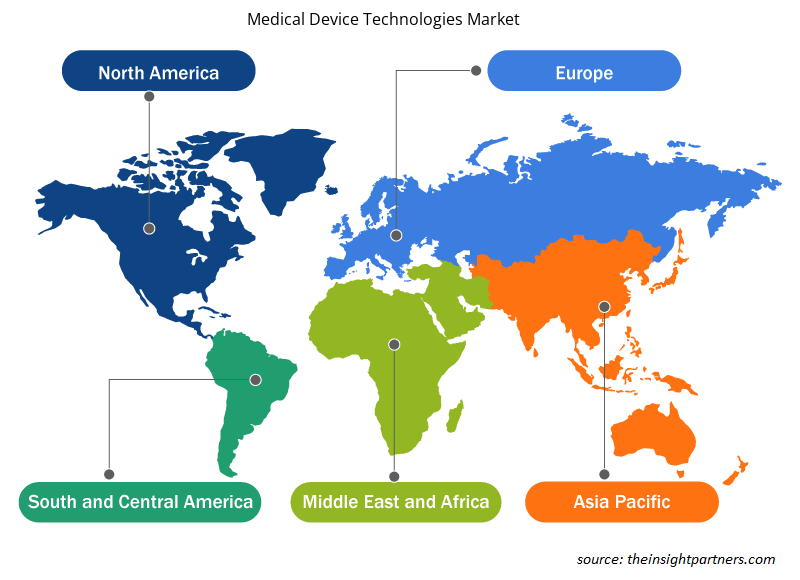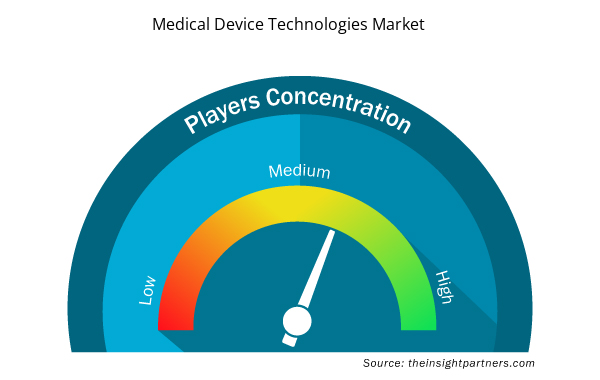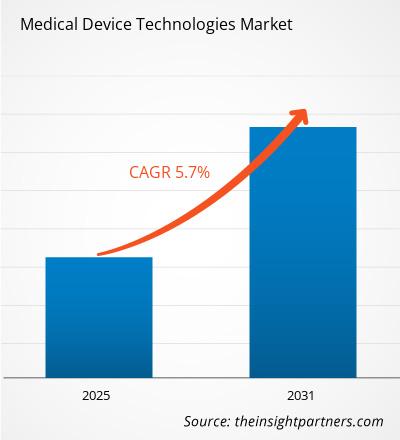Si prevede che il mercato delle tecnologie dei dispositivi medici registrerà un CAGR del 5,7% dal 2024 al 2031, con una dimensione di mercato in espansione da XX milioni di dollari nel 2024 a XX milioni di dollari entro il 2031.
Il rapporto è suddiviso in base al tipo di dispositivo (dispositivi diagnostici in vitro (IVD), dispositivi cardiologici, dispositivi di diagnostica per immagini, dispositivi ortopedici, dispositivi oftalmologici, dispositivi endoscopici, dispositivi per la cura del diabete, dispositivi per la gestione delle ferite, dispositivi renali/dialisi, dispositivi per anestesia e cure respiratorie e altri). Il rapporto presenta inoltre un'analisi basata sull'utente finale (ospedali e cliniche, centri di assistenza ambulatoriale, assistenza domiciliare e altri). L'analisi globale è ulteriormente suddivisa a livello regionale e nei principali paesi. Il rapporto offre il valore in USD per l'analisi e i segmenti di cui sopra.
Scopo del rapporto
Il report Medical Device Technologies Market di The Insight Partners mira a descrivere il panorama attuale e la crescita futura, i principali fattori trainanti, le sfide e le opportunità. Ciò fornirà spunti a vari stakeholder aziendali, come:
- Fornitori/produttori di tecnologia: per comprendere le dinamiche di mercato in evoluzione e conoscere le potenziali opportunità di crescita, consentendo loro di prendere decisioni strategiche informate.
- Investitori: condurre un'analisi completa delle tendenze in merito al tasso di crescita del mercato, alle proiezioni finanziarie del mercato e alle opportunità esistenti lungo la catena del valore.
- Enti di regolamentazione: regolamentano le politiche e le attività di controllo sul mercato allo scopo di ridurre al minimo gli abusi, preservare la fiducia degli investitori e sostenere l'integrità e la stabilità del mercato.
Segmentazione del mercato delle tecnologie dei dispositivi medici
Tipo di dispositivo
- Dispositivi diagnostici in vitro
- Dispositivi cardiologici
- Dispositivi di diagnostica per immagini
- Dispositivi ortopedici
- Dispositivi per l'oftalmologia
- Dispositivi per endoscopia
- Dispositivi per la cura del diabete
- Dispositivi per la gestione delle ferite
- Dispositivi renali/dialisi
- Dispositivi per anestesia e terapia respiratoria
- Altri
Utente finale
- Ospedali e cliniche
- Centri di assistenza ambulatoriale
- Assistenza domiciliare
- Altri
Personalizza questo report in base alle tue esigenze
Riceverai la personalizzazione gratuita di qualsiasi report, comprese parti di questo report, o analisi a livello nazionale, pacchetto dati Excel, oltre a usufruire di grandi offerte e sconti per start-up e università
- Scopri le principali tendenze di mercato in questo rapporto.Questo campione GRATUITO includerà analisi di dati che spaziano dalle tendenze di mercato alle stime e alle previsioni.
Driver di crescita del mercato delle tecnologie dei dispositivi medici
- Crescita del settore dei dispositivi medici: i dispositivi medici sono essenziali per la diagnosi di prevenzione delle malattie, il trattamento e la riabilitazione di qualsiasi condizione medica. Secondo AdvaMed, gli Stati Uniti sono il più grande mercato di dispositivi medici al mondo, comprendendo oltre il 40% del mercato globale della tecnologia medica.
- Aumento della prevalenza delle malattie croniche:
l'aumento della prevalenza delle malattie croniche, come malattie neurologiche, malattie cardiovascolari (CVD), cancro, diabete, ictus e malattie renali, aumenta la domanda di dispositivi medici per scopi di diagnosi e trattamento. Secondo il CDC, negli Stati Uniti, il novanta percento della spesa sanitaria annuale di 4,5 trilioni di dollari USA è destinata a persone con condizioni di salute mentale e croniche. - Adozione della salute digitale: i miglioramenti nella salute digitale sono il fattore chiave che guida il mercato delle tecnologie dei dispositivi medici. L'adozione crescente della salute digitale nella telemedicina e nel monitoraggio remoto dei pazienti e i progressi nell'intelligenza artificiale, nell'apprendimento automatico e nell'IoT stanno potenziando lo sviluppo di dispositivi più sofisticati che potrebbero raccogliere e analizzare i dati dei pazienti in tempo reale, migliorando così i risultati sanitari e riducendo i costi.
Tendenze future del mercato delle tecnologie dei dispositivi medici
- Dispositivi medici intelligenti che rivoluzionano il settore dei dispositivi medici: l'Internet of Things (IoT) sta rivoluzionando il settore della salute e della medicina e sta apportando enormi sviluppi. Solide attività di R&S nel settore sanitario hanno portato a innovazioni nei dispositivi medici. Le aziende di dispositivi medici stanno incorporando l'intelligenza artificiale (IA) e l'IoT per migliorare i risultati clinici
- Sviluppo di dispositivi medici monouso: sviluppo di dispositivi medici monouso per ridurre le possibilità di infezione durante le procedure di trattamento. Nel 2024, Inspira Technologies OXY BHN Ltd., un pioniere nella tecnologia di supporto vitale, ha annunciato il suo piano di lanciare un kit monouso monouso per l'ossigenazione del sangue.
- Sviluppo di robot chirurgici: i robot chirurgici eseguono procedure minimamente invasive e offrono controllo, precisione e flessibilità durante le procedure chirurgiche. A giugno 2024, Meril, un'azienda di dispositivi medici con sede in India, ha annunciato il lancio della sua tecnologia robotica chirurgica avanzata sviluppata, MISSO, che fornirà assistenza ai chirurghi durante le procedure di sostituzione del ginocchio in tempo reale.
Opportunità di mercato per le tecnologie dei dispositivi medici
- Aumento degli investimenti nelle tecnologie mediche: gli investimenti per le attività di ricerca e sviluppo mediche sono in aumento in tutto il mondo. Secondo il Germany Trade & Investreport, la spesa per la tecnologia medica e la diagnostica in vitro (IVD) in Germania ha raggiunto i 43 miliardi di euro nel 2022.
- Biomateriali avanzati: c'è spazio per il business nello sviluppo di biomateriali avanzati che saranno applicati ai dispositivi medici. Nuovi biomateriali come nanomateriali, polimeri e ceramiche, sono ampiamente utilizzati nel settore dei dispositivi medici, a causa della crescente necessità di dispositivi biocompatibili, che siano più resistenti ed efficienti.
- Espansione nei mercati emergenti: si prevede che il settore dei dispositivi medici si espanderà rapidamente nei mercati emergenti dell'Asia-Pacifico e dell'America Latina a causa dell'elevata domanda di dispositivi medici. Secondo Invest India, l'India è il quarto mercato più grande per i dispositivi medici in Asia. Si prevede che uno scenario di rimborso migliorato e un crescente investimento da parte del governo nell'aumento del settore della tecnologia medica offriranno opportunità
Approfondimenti regionali sul mercato delle tecnologie dei dispositivi medici
Le tendenze regionali e i fattori che influenzano il mercato delle tecnologie per dispositivi medici durante il periodo di previsione sono stati ampiamente spiegati dagli analisti di Insight Partners. Questa sezione discute anche i segmenti e la geografia del mercato delle tecnologie per dispositivi medici in Nord America, Europa, Asia Pacifico, Medio Oriente e Africa e America centrale e meridionale.

- Ottieni i dati specifici regionali per il mercato delle tecnologie dei dispositivi medici
Ambito del rapporto di mercato sulle tecnologie dei dispositivi medici
| Attributo del report | Dettagli |
|---|---|
| Dimensioni del mercato nel 2024 | XX milioni di dollari USA |
| Dimensioni del mercato entro il 2031 | XX milioni di dollari USA |
| CAGR globale (2025 - 2031) | 5,7% |
| Dati storici | 2021-2023 |
| Periodo di previsione | 2025-2031 |
| Segmenti coperti | Per tipo di dispositivo
|
| Regioni e Paesi coperti | America del Nord
|
| Leader di mercato e profili aziendali chiave |
|
Densità degli attori del mercato delle tecnologie dei dispositivi medici: comprendere il suo impatto sulle dinamiche aziendali
Il mercato delle tecnologie per dispositivi medici sta crescendo rapidamente, spinto dalla crescente domanda degli utenti finali dovuta a fattori quali l'evoluzione delle preferenze dei consumatori, i progressi tecnologici e una maggiore consapevolezza dei benefici del prodotto. Con l'aumento della domanda, le aziende stanno ampliando le loro offerte, innovando per soddisfare le esigenze dei consumatori e capitalizzando sulle tendenze emergenti, il che alimenta ulteriormente la crescita del mercato.
La densità degli operatori di mercato si riferisce alla distribuzione di aziende o società che operano in un particolare mercato o settore. Indica quanti concorrenti (operatori di mercato) sono presenti in un dato spazio di mercato in relazione alle sue dimensioni o al valore di mercato totale.
Le principali aziende che operano nel mercato delle tecnologie dei dispositivi medici sono:
- SERVIZI JOHNSON & JOHNSON, INC.
- ELETTRICA GENERALE
- SMITH E NIPOTE
- STRINGITORE
- MEDTRONIC
Disclaimer : le aziende elencate sopra non sono classificate secondo un ordine particolare.

- Ottieni una panoramica dei principali attori del mercato delle tecnologie dei dispositivi medici
Punti di forza chiave
- Copertura completa: il rapporto copre in modo completo l'analisi di prodotti, servizi, tipologie e utenti finali del mercato delle tecnologie dei dispositivi medici, fornendo una panoramica olistica.
- Analisi degli esperti: il rapporto è compilato sulla base della conoscenza approfondita di esperti e analisti del settore.
- Informazioni aggiornate: il rapporto garantisce la pertinenza aziendale grazie alla copertura di informazioni recenti e tendenze nei dati.
- Opzioni di personalizzazione: questo report può essere personalizzato per soddisfare le esigenze specifiche del cliente e adattarsi in modo appropriato alle strategie aziendali.
Il rapporto di ricerca sul mercato delle tecnologie dei dispositivi medici può quindi aiutare a guidare il percorso di decodifica e comprensione dello scenario del settore e delle prospettive di crescita. Sebbene possano esserci alcune preoccupazioni valide, i vantaggi complessivi di questo rapporto tendono a superare gli svantaggi.
- Analisi storica (2 anni), anno base, previsione (7 anni) con CAGR
- Analisi PEST e SWOT
- Valore/volume delle dimensioni del mercato - Globale, regionale, nazionale
- Industria e panorama competitivo
- Set di dati Excel


- Micro-Surgical Robot Market
- Artificial Intelligence in Healthcare Diagnosis Market
- Fill Finish Manufacturing Market
- Bioremediation Technology and Services Market
- Electronic Toll Collection System Market
- Personality Assessment Solution Market
- Single Pair Ethernet Market
- Bathroom Vanities Market
- UV Curing System Market
- Artificial Intelligence in Defense Market

Report Coverage
Revenue forecast, Company Analysis, Industry landscape, Growth factors, and Trends

Segment Covered
This text is related
to segments covered.

Regional Scope
North America, Europe, Asia Pacific, Middle East & Africa, South & Central America

Country Scope
This text is related
to country scope.
Domande frequenti
The medical device technologies market is estimated to grow with a CAGR of 5.7% from 2023 to 2031.
Asia Pacific region is likely to witness the fastest growth rate during the forecast period.
The market drivers include the increasing prevalence of chronic disorders and growing global medical device industry, which are driving the medical device technologies market.
The medical device technologies market majorly consists of players such as Stryker, Medtronic, Zimmer Biomet Holding Inc., among others.
Development of surgical robots are likely to remain the key trend during the forecast period.
North America dominated the medical device technologies market in 2023
Trends and growth analysis reports related to Life Sciences : READ MORE..
1. JOHNSON & JOHNSON SERVICES, INC.
2. GENERAL ELECTRIC
3. SMITH & NEPHEW
4. STRYKER
5. MEDTRONIC
6. SIEMENS HEALTHCARE PRIVATE LIMITED
7. KONINKLIJKE PHILIPS N.V.
8. F. HOFFMANN-LA ROCHE LTD
9. ABBOTT.
10. BOSTON SCIENTIFIC CORPORATION
The Insight Partners performs research in 4 major stages: Data Collection & Secondary Research, Primary Research, Data Analysis and Data Triangulation & Final Review.
- Data Collection and Secondary Research:
As a market research and consulting firm operating from a decade, we have published and advised several client across the globe. First step for any study will start with an assessment of currently available data and insights from existing reports. Further, historical and current market information is collected from Investor Presentations, Annual Reports, SEC Filings, etc., and other information related to company’s performance and market positioning are gathered from Paid Databases (Factiva, Hoovers, and Reuters) and various other publications available in public domain.
Several associations trade associates, technical forums, institutes, societies and organization are accessed to gain technical as well as market related insights through their publications such as research papers, blogs and press releases related to the studies are referred to get cues about the market. Further, white papers, journals, magazines, and other news articles published in last 3 years are scrutinized and analyzed to understand the current market trends.
- Primary Research:
The primarily interview analysis comprise of data obtained from industry participants interview and answers to survey questions gathered by in-house primary team.
For primary research, interviews are conducted with industry experts/CEOs/Marketing Managers/VPs/Subject Matter Experts from both demand and supply side to get a 360-degree view of the market. The primary team conducts several interviews based on the complexity of the markets to understand the various market trends and dynamics which makes research more credible and precise.
A typical research interview fulfils the following functions:
- Provides first-hand information on the market size, market trends, growth trends, competitive landscape, and outlook
- Validates and strengthens in-house secondary research findings
- Develops the analysis team’s expertise and market understanding
Primary research involves email interactions and telephone interviews for each market, category, segment, and sub-segment across geographies. The participants who typically take part in such a process include, but are not limited to:
- Industry participants: VPs, business development managers, market intelligence managers and national sales managers
- Outside experts: Valuation experts, research analysts and key opinion leaders specializing in the electronics and semiconductor industry.
Below is the breakup of our primary respondents by company, designation, and region:

Once we receive the confirmation from primary research sources or primary respondents, we finalize the base year market estimation and forecast the data as per the macroeconomic and microeconomic factors assessed during data collection.
- Data Analysis:
Once data is validated through both secondary as well as primary respondents, we finalize the market estimations by hypothesis formulation and factor analysis at regional and country level.
- Macro-Economic Factor Analysis:
We analyse macroeconomic indicators such the gross domestic product (GDP), increase in the demand for goods and services across industries, technological advancement, regional economic growth, governmental policies, the influence of COVID-19, PEST analysis, and other aspects. This analysis aids in setting benchmarks for various nations/regions and approximating market splits. Additionally, the general trend of the aforementioned components aid in determining the market's development possibilities.
- Country Level Data:
Various factors that are especially aligned to the country are taken into account to determine the market size for a certain area and country, including the presence of vendors, such as headquarters and offices, the country's GDP, demand patterns, and industry growth. To comprehend the market dynamics for the nation, a number of growth variables, inhibitors, application areas, and current market trends are researched. The aforementioned elements aid in determining the country's overall market's growth potential.
- Company Profile:
The “Table of Contents” is formulated by listing and analyzing more than 25 - 30 companies operating in the market ecosystem across geographies. However, we profile only 10 companies as a standard practice in our syndicate reports. These 10 companies comprise leading, emerging, and regional players. Nonetheless, our analysis is not restricted to the 10 listed companies, we also analyze other companies present in the market to develop a holistic view and understand the prevailing trends. The “Company Profiles” section in the report covers key facts, business description, products & services, financial information, SWOT analysis, and key developments. The financial information presented is extracted from the annual reports and official documents of the publicly listed companies. Upon collecting the information for the sections of respective companies, we verify them via various primary sources and then compile the data in respective company profiles. The company level information helps us in deriving the base number as well as in forecasting the market size.
- Developing Base Number:
Aggregation of sales statistics (2020-2022) and macro-economic factor, and other secondary and primary research insights are utilized to arrive at base number and related market shares for 2022. The data gaps are identified in this step and relevant market data is analyzed, collected from paid primary interviews or databases. On finalizing the base year market size, forecasts are developed on the basis of macro-economic, industry and market growth factors and company level analysis.
- Data Triangulation and Final Review:
The market findings and base year market size calculations are validated from supply as well as demand side. Demand side validations are based on macro-economic factor analysis and benchmarks for respective regions and countries. In case of supply side validations, revenues of major companies are estimated (in case not available) based on industry benchmark, approximate number of employees, product portfolio, and primary interviews revenues are gathered. Further revenue from target product/service segment is assessed to avoid overshooting of market statistics. In case of heavy deviations between supply and demand side values, all thes steps are repeated to achieve synchronization.
We follow an iterative model, wherein we share our research findings with Subject Matter Experts (SME’s) and Key Opinion Leaders (KOLs) until consensus view of the market is not formulated – this model negates any drastic deviation in the opinions of experts. Only validated and universally acceptable research findings are quoted in our reports.
We have important check points that we use to validate our research findings – which we call – data triangulation, where we validate the information, we generate from secondary sources with primary interviews and then we re-validate with our internal data bases and Subject matter experts. This comprehensive model enables us to deliver high quality, reliable data in shortest possible time.


 Ottieni un campione gratuito per questo repot
Ottieni un campione gratuito per questo repot